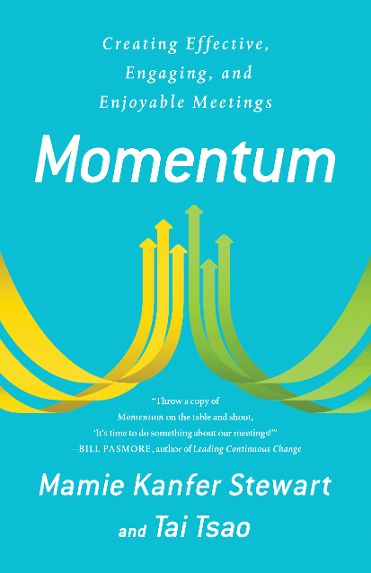Mamie Kanfer Stewart is CEO and founder of Meeteor and author of Momentum: Creating Effective, Engaging and Enjoyable Meetings. Mamie is passionate about helping others optimize their time and cultivate their team to achieve their goals. As a speaker and facilitator, Mamie teaches and speaks about effective meeting practices and changing meeting culture. She has been a guest on numerous leadership and productivity podcasts and has been featured in Forbes, Inc, Business Collective, and PCMag.
Today, we will be talking with her about how leaders can hold more effective and engaging meetings.
Q. Welcome to StartUp Mindset, Mamie. For those readers that are not familiar with you, could you tell us a little about yourself and your entrepreneurship background?
From a young age, I was driven to make things better—more effective, more efficient, more enjoyable. I started my first business at age twelve, when I decided I could run a better summer camp than the one I’d attended for the past two years. The experience crystallized my passion for making something better in a way that benefits others—a passion that still drives me today.
Shortly after I graduated from college, I began working in my family’s enterprise, GOJO Industries, a global leader in hygiene and skin health and the inventor of PURELL® Instant Hand Sanitizer. I learned about running an effective meeting and other collaboration practices through osmosis. I didn’t realize the practices at GOJO were unusual until I started working elsewhere and was surprised the lack of meeting preparation, meeting follow-through and more. A few years ago, I launched Meeteor to help solve what I see as one of the biggest forms of waste in business today: unproductive meetings.
Q. Tell us more about your current company Meeteor?
Meeteor helps individuals and teams thrive at work. We offer trainings, skill-building programs and individual and team coaching programs to help people develop collaboration skills and improve their meeting practices. We also write about collaboration and meeting best practices on our blog and in major publications.
To raise the awareness of the problem with meetings and inspire more people to take action, I speak at conferences and company retreats about the hidden costs of unproductive meetings, the relationship between meetings and culture, and what every leader can do to build a movement for better meetings.
Q. In your new book, Momentum, you address some of the common and persistent problems with meetings. What are some of the problems you wrote about in your book?
Based on research and our experience working with hundreds of clients, two problems really stand out for everyday meeting participants. First, not knowing what the meeting is intended to achieve, and specifically, why they are invited to the meeting. Second, leaving the meeting without clear decisions or next steps. In both cases, the entire meeting can be a waste of time, leaving people to complain that meetings feel like a distraction from their “real” work.
Other common problems we hear include the overwhelming number of meetings people go to, the feeling that their day is run by their calendar, no one coming prepared for meetings, and unhealthy group dynamics in meetings. These are just a few issues, but the impact of these problems are much deeper.
Q. What are the hidden costs of bad meetings?
It’s easy to see how unproductive meetings waste time, but they also waste money. When you calculate the amount of hours spent in wasteful meetings by the salaries of those in attendance, you realize the magnitude of the problem. Some reports put the total financial loss from time in meetings at over $1 billion in America alone.
This is also a productivity problem. Not only is there an opportunity cost–the time wasted in meetings could have been spent on more important work–but there is also additional productivity loss through confusion and lack of transparency. When meeting outcomes are unclear, people leave with different understandings of a decision or next steps which can lead to doing the wrong work. Similarly, when meeting outcomes aren’t communicated consistently and accurately, work gets delayed or never happens at all, both of which can negatively impact the overall results.
Bad meetings are also a reflection of and have an impact on the organization’s culture which in turn affects employee morale, engagement and retention. Meeting practices are an expression of what the organization values. For example, if meetings don’t foster open dialogue, it’s unlikely employees will think their opinions and thoughts are desired and therefore they may not feel valued by the organization. The organization is losing out on good ideas, and just as important, the employees may feel frustrated with their colleagues in meetings or demotivated to contribute their best work, resulting in a sub-optimal work environment.
Q. What are few ways leaders can improve the quality and effectiveness of their meetings right away?
Two simple practices that leaders can implement are the desired outcome and wrap up. A desired outcome is the result the meeting intends to achieve. This is different from what you’ll do at the meeting. It’s not enough to say you’re having a check-in meeting or a meeting to discuss last quarters results or review the customer’s feedback. How will you know that meeting was successful?
A good, interesting conversation is not the same as a productive meeting that moves work forward. Instead, write a desired outcome statement by filling in the blank: “At the end of this meeting we will have…” This could be a list of ideas, a decision, alignment on revisions, clear next steps, etc. When you know a meeting’s desired outcome, you are able to plan the agenda in order to reach that outcome.
The second practice is ending with a wrap up. Use the last five minutes of the meeting to review and confirm all decisions and next steps. Ask the group “what did we agree to?” and “what are the next steps – who will do what by when?” Type the responses into a document or email and immediately share with the meeting participants and other stakeholders who need to be informed. When you end with a wrap up, everyone leaves the meeting with the same understanding and feels positive about what the group accomplished during its time together.
Q. Because it is more and more common to have a remote team, how can entrepreneurs make the most of their virtual meetings?
Virtual meetings have all the same challenges as any other meetings and more. In addition to always starting with a desired outcome and ending with a wrap up, there are a few other approaches to specifically support virtual meetings. First, make sure you have the optimal technology. Nothing is more frustrating and disengaging to virtual participants than when they can’t hear the conversation. Whenever possible, opt for video over audio only. Seeing faces and body language helps build relationships and keep people’s attention.
You can learn more about Mamie Kanfer’s work at www.mamieks.com and www.meeteor.com, or follow on social media @mamieKS and @meeteorHQ.











Pingback: 6 Common Mistakes to Avoid if You Want to Have Effective Meetings – LewLewBiz
Pingback: 6 Common Mistakes to Avoid if You Want to Have Effective Meetings - StartUp Mindset
Pingback: How to Keep Your Meeting on Track - StartUp Mindset
Pingback: Creating More Effective and Engaging Meetings: Interview with Meeteor Founder Mamie Kanfer | GeorgMedia Internet Marketing News & Resources